 How do you know what the best cookware material is? There are just so many choices from stainless steel, copper, aluminum, cast iron, ceramic and mixtures of multiple materials in one pot or pan so it can get overwhelmingly confusing very quickly. Not all materials used in cookware are suited for every type of use. Some are great at conducting heat, but can be difficult to clean or unsuited for certain cooking methods or for cooking certain foods. Before I dive into the different materials, it is useful to understand what reactive and non-reactive materials are and how they affect what you’re cooking.
How do you know what the best cookware material is? There are just so many choices from stainless steel, copper, aluminum, cast iron, ceramic and mixtures of multiple materials in one pot or pan so it can get overwhelmingly confusing very quickly. Not all materials used in cookware are suited for every type of use. Some are great at conducting heat, but can be difficult to clean or unsuited for certain cooking methods or for cooking certain foods. Before I dive into the different materials, it is useful to understand what reactive and non-reactive materials are and how they affect what you’re cooking.
What is Reactive & Non-Reactive In Cookware Terms?
In the most simple terms, non-reactive means that the material will not react with the food that you cook to cause bad flavors or discolorations. Reactive would be the opposite, where it means that some foods will react to the material used in the cookware. You would not want to use reactive materials cooking those foods.
What Does Reactive Cookware Do?’
Reactive cookware can leach materials from the cookware into your food which can affect flavor and discolor what you’re cooking. This is generally only the case with certain foods, such as acidic ingredients like tomato, citrus or if you have a long cooking time they can impart a metallic flavor into your food. Some people have concerns about what materials are being leached into the food, similar to concerns with Teflon or other non-stick materials. On the other end of the spectrum, alkaline foods also can leach materials from cookware. So if you ask me, reactive cookware should be used in a very limited manner for neutral or close to neutral pH foods.
Top Cookware Materials
Let’s take a look at the most common materials used in cookware and see what they are good for and what you would also not want to use them for.
Stainless Steel
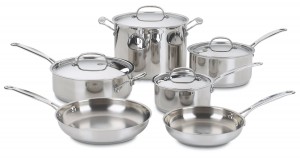 Stainless is probably one of the best known and most popularly sought-after materials used in cookware. Stainless is great for easy cleaning and it is “non-reactive” – more on what non-reactive is later. Stainless steel can also have “hot spots” or areas in a given pot or pan where heat is concentrated. This can lead to overcooking or even burning when cooking in that area. For example pan frying a steak could lead to part of it being cooked more than other parts. Stainless steel is also inefficient at conducting heat, so it can take longer to heat up than other materials but once heated it can stay hot much longer, because it is also inefficient at dispensing that heat. This is great when looking to keep something warm, but also tricky to cook something that will need to be removed from heat immediately upon reaching desired temperature. This is one of the major reasons you will see aluminum and copper used as “core” materials inside or on the base of the pan to help conduct heat better. See Stainless Cookware Here.
Stainless is probably one of the best known and most popularly sought-after materials used in cookware. Stainless is great for easy cleaning and it is “non-reactive” – more on what non-reactive is later. Stainless steel can also have “hot spots” or areas in a given pot or pan where heat is concentrated. This can lead to overcooking or even burning when cooking in that area. For example pan frying a steak could lead to part of it being cooked more than other parts. Stainless steel is also inefficient at conducting heat, so it can take longer to heat up than other materials but once heated it can stay hot much longer, because it is also inefficient at dispensing that heat. This is great when looking to keep something warm, but also tricky to cook something that will need to be removed from heat immediately upon reaching desired temperature. This is one of the major reasons you will see aluminum and copper used as “core” materials inside or on the base of the pan to help conduct heat better. See Stainless Cookware Here.
Ceramic
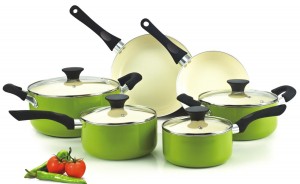 Most modern ceramic cookware (as in pots and pans) is either coated with enamel or another non-stick coating which some people have safety concerns about. Ceramic cookware can also have hot spots, take a long time to heat and cool down and are non-reactive. They can also be a bit on the heavier side and more prone to damage should you drop them compared to other materials like cast iron which could be more prone to damage whatever you drop it on. I love the feel of older ceramic cookware with an enamel coating. It just has a special vintage and rustic feel to me. The new ones, not so much. See Ceramic Cookware Here.
Most modern ceramic cookware (as in pots and pans) is either coated with enamel or another non-stick coating which some people have safety concerns about. Ceramic cookware can also have hot spots, take a long time to heat and cool down and are non-reactive. They can also be a bit on the heavier side and more prone to damage should you drop them compared to other materials like cast iron which could be more prone to damage whatever you drop it on. I love the feel of older ceramic cookware with an enamel coating. It just has a special vintage and rustic feel to me. The new ones, not so much. See Ceramic Cookware Here.
Copper
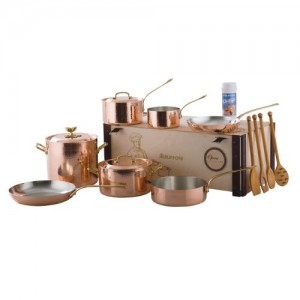 Copper cookware looks incredibly rich to me. I absolutely love the warm and again rustic feeling that I get using them. However, copper is reactive so it should be used in very limited applications. Copper has excellent heat conductive qualities and is very effective to cook with because of that. It is also very expensive, especially as copper prices have risen sharply in recent years. My personal preference would be to use a copper-core stainless cookware set for most cooking but cost is still a factor for myself, and many others. See Copper Cookware Here.
Copper cookware looks incredibly rich to me. I absolutely love the warm and again rustic feeling that I get using them. However, copper is reactive so it should be used in very limited applications. Copper has excellent heat conductive qualities and is very effective to cook with because of that. It is also very expensive, especially as copper prices have risen sharply in recent years. My personal preference would be to use a copper-core stainless cookware set for most cooking but cost is still a factor for myself, and many others. See Copper Cookware Here.
Aluminum
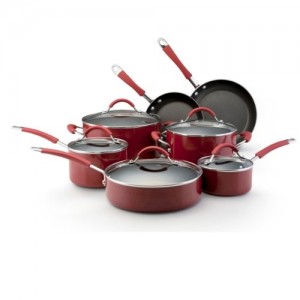 Aluminum also has great heat conductive qualities as long as it is not “cast” aluminum but again is reactive. Cast aluminum is still reactive and and does not have the heat conductivity that sheet aluminum does. You can tell the difference usually by looking and seeing if the pot or pan appears “formed” or “poured” which can have some visual clues such as being a little porous. Things like aluminum dutch ovens or camp cookware many times are cast. Aluminum is generally not used as the primary material in quality cookware, but it can be used as a core material to take advantage of the heat transfer qualities in non-stick or stainless cookware. Sheet formed aluminum cookware can warp under high heats also. So while they can be quite inexpensive cookware, longevity may be an issue. For all these reasons, I generally recommend against primarily aluminum cookware. That being said, I do own one large aluminum pan with a non-stick coating. It was quite cheap for the size and I have definitely experienced the warping common especially with large pans made from aluminum. See Anodized Aluminum Cookware Here.
Aluminum also has great heat conductive qualities as long as it is not “cast” aluminum but again is reactive. Cast aluminum is still reactive and and does not have the heat conductivity that sheet aluminum does. You can tell the difference usually by looking and seeing if the pot or pan appears “formed” or “poured” which can have some visual clues such as being a little porous. Things like aluminum dutch ovens or camp cookware many times are cast. Aluminum is generally not used as the primary material in quality cookware, but it can be used as a core material to take advantage of the heat transfer qualities in non-stick or stainless cookware. Sheet formed aluminum cookware can warp under high heats also. So while they can be quite inexpensive cookware, longevity may be an issue. For all these reasons, I generally recommend against primarily aluminum cookware. That being said, I do own one large aluminum pan with a non-stick coating. It was quite cheap for the size and I have definitely experienced the warping common especially with large pans made from aluminum. See Anodized Aluminum Cookware Here.
Anodized Aluminum
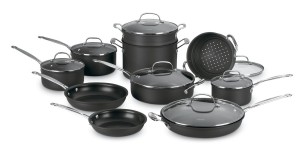 Anodizing is a special process performed on aluminum to create (in the cookware world) a surface that is both non-porous and non-reactive. These are very popular cookware and seem to be much safer than plain old aluminum. However, some concerns still exist about the amount of aluminum possibly leached into foods especially at higher heats. The surface is somewhat scratch resistant and non-stick, but it can wear down after time especially if you are the type to use a knife or other sharp utensils in the pan (really bad idea – stop it!) If you are going to choose aluminum, I would personally lean toward anodized aluminum for the benefits and possible lower health risks. See Aluminum Cookware Here.
Anodizing is a special process performed on aluminum to create (in the cookware world) a surface that is both non-porous and non-reactive. These are very popular cookware and seem to be much safer than plain old aluminum. However, some concerns still exist about the amount of aluminum possibly leached into foods especially at higher heats. The surface is somewhat scratch resistant and non-stick, but it can wear down after time especially if you are the type to use a knife or other sharp utensils in the pan (really bad idea – stop it!) If you are going to choose aluminum, I would personally lean toward anodized aluminum for the benefits and possible lower health risks. See Aluminum Cookware Here.
Cast Iron
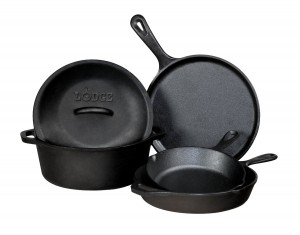 Cast Iron cookware is also reactive and can leach materials into your food. However, our bodies tolerate iron much better than other materials like aluminum or copper. Some people may consider a little iron supplemented into their diet a health benefit especially if they don’t eat a lot of red meat. Again, I love the rustic feel that a nice cast iron skillet or dutch oven can instill and love to use it to cook over an open flame, such as a camp fire or gas burner. I swear it adds to the flavor of a good steak to pan sear it on a cast iron skillet. Cast iron is also very durable although extremely heavy and will require regular use or seasoning with oil or fats to stay rust free. You do not want to wash cast iron cookware with soap as it will remove the protective oil coating and lead to rusting. See Cast Iron Cookware Here.
Cast Iron cookware is also reactive and can leach materials into your food. However, our bodies tolerate iron much better than other materials like aluminum or copper. Some people may consider a little iron supplemented into their diet a health benefit especially if they don’t eat a lot of red meat. Again, I love the rustic feel that a nice cast iron skillet or dutch oven can instill and love to use it to cook over an open flame, such as a camp fire or gas burner. I swear it adds to the flavor of a good steak to pan sear it on a cast iron skillet. Cast iron is also very durable although extremely heavy and will require regular use or seasoning with oil or fats to stay rust free. You do not want to wash cast iron cookware with soap as it will remove the protective oil coating and lead to rusting. See Cast Iron Cookware Here.
Enameled Cast Iron
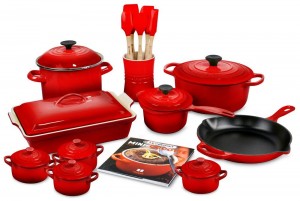 To get all the benefits of cast iron without any of the maintenance, you might consider looking into investing into enamel coated cast iron. I say “investing” because they definitely aren’t on the cheaper end of affordable – Le Creuset is probably one of the most recognized brands and single pots or pans can easily reach $300 and more. However, they are very durable and excellent to cook with. I strongly discourage people from buying cheaper enamel coated cast iron cookware as many of them can chip and then you’ve just wasted your money. You’re better off saving or choosing a different material instead of buying cheap enamel coated cast iron cookware. See Enameled Cast Iron Cookware Here.
To get all the benefits of cast iron without any of the maintenance, you might consider looking into investing into enamel coated cast iron. I say “investing” because they definitely aren’t on the cheaper end of affordable – Le Creuset is probably one of the most recognized brands and single pots or pans can easily reach $300 and more. However, they are very durable and excellent to cook with. I strongly discourage people from buying cheaper enamel coated cast iron cookware as many of them can chip and then you’ve just wasted your money. You’re better off saving or choosing a different material instead of buying cheap enamel coated cast iron cookware. See Enameled Cast Iron Cookware Here.
Carbon Steel
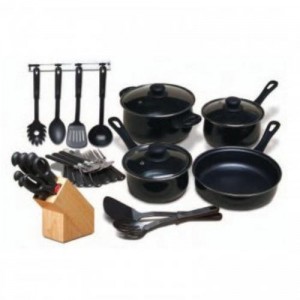 Carbon steel cookware are generally only used in specialized cooking such as woks or paella pans. They are generally very thin material, easy to handle and used in high-heat and fast cooking. I recommend having a carbon steel wok or other specific-purpose pan, but don’t look for an entire set made from carbon steel as they are cheap and not very good for general purpose cooking. See Carbon Steel Cookware Here.
Carbon steel cookware are generally only used in specialized cooking such as woks or paella pans. They are generally very thin material, easy to handle and used in high-heat and fast cooking. I recommend having a carbon steel wok or other specific-purpose pan, but don’t look for an entire set made from carbon steel as they are cheap and not very good for general purpose cooking. See Carbon Steel Cookware Here.
Enameled Steel
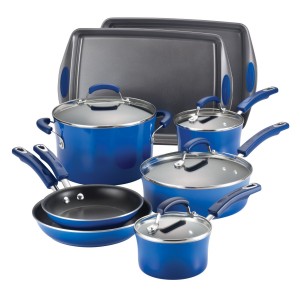 Enameled steel cookware is most of the time just an enamel coating on top of regular steel or carbon steel. It is usually quite inexpensive and typically not very high quality. While it does have the benefit of being non-stick, high heat is usually not recommended and can cause damage and deterioration of the enamel coating along with potential for warping of the steel itself, especially if the pans are thin. See Enameled Steel Cookware Here.
Enameled steel cookware is most of the time just an enamel coating on top of regular steel or carbon steel. It is usually quite inexpensive and typically not very high quality. While it does have the benefit of being non-stick, high heat is usually not recommended and can cause damage and deterioration of the enamel coating along with potential for warping of the steel itself, especially if the pans are thin. See Enameled Steel Cookware Here.
So, What’s the Best?
In my opinion there really isn’t one clear winner because each type has specific applications where they may excel over the other such as woks or cast iron skillets. My personal preference is to build my own cookware set from various materials based to support what I like to cook on a regular basis. That being said, if I were to pick an off the shelf cookware set I would probably choose one of these 3 sets which are constructed of multiple materials with a stainless outside because they present a “best of all worlds” option in one set. Value: Cuisinart MCP-12 MultiClad Pro Stainless Steel 12-Piece Cookware Set Mid Range: Cuisinart CTP-11AM Copper Tri-Ply Stainless Steel 11-Piece Cookware Set Quality: All-Clad 60090 Copper Core 5-Ply Bonded Dishwasher Safe 14-Piece Cookware Set
